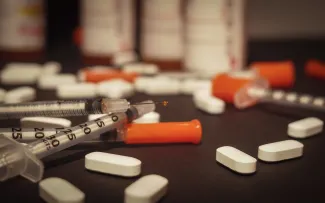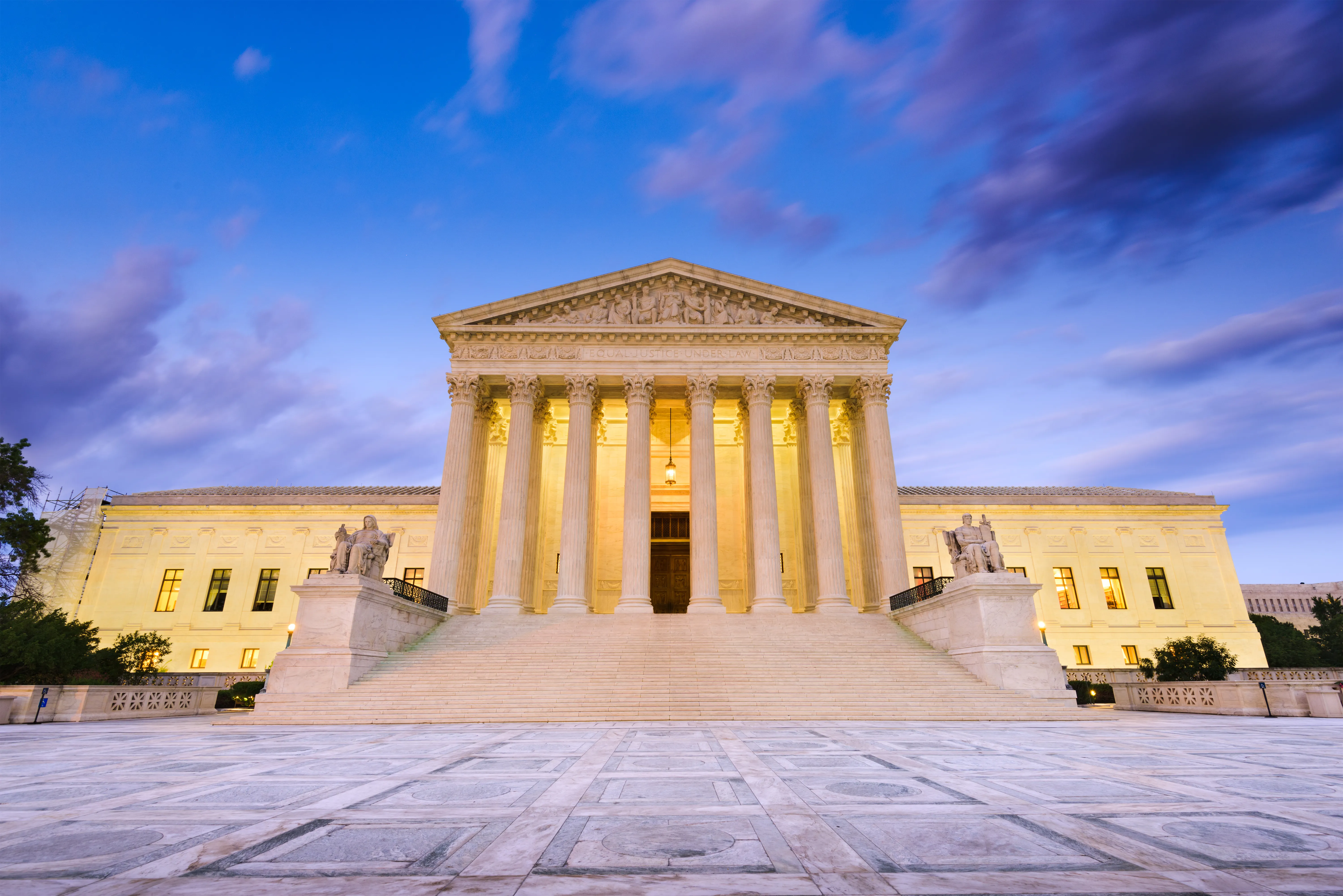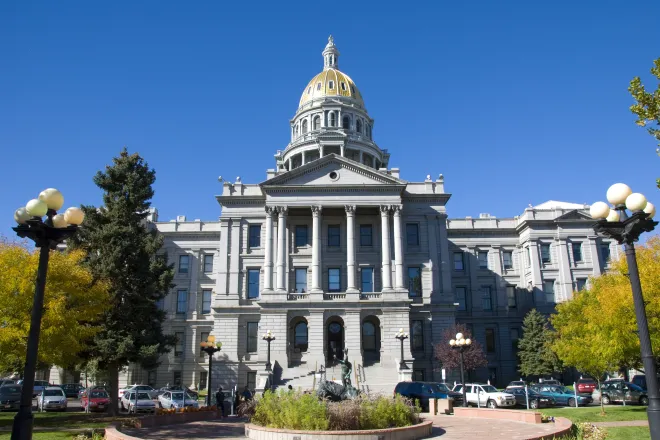
Colorado’s naloxone fund is drying up, even as opioid settlement money rolls in
(Colorado Newsline) On a bustling street corner one recent afternoon outside the offices of the Harm Reduction Action Center, employees of the education and advocacy nonprofit handed out free naloxone kits to passersby.
Distributing the opioid reversal medication is essential to the center’s work to reduce fatal overdoses in the community. But how long the group can continue doing so is in question.
The center depends on Colorado’s Opioid Antagonist Bulk Purchase Fund, also known as the Naloxone Bulk Purchase Fund, which now lacks a recurring source of money — despite hundreds of millions of dollars in national opioid lawsuit settlement cash flowing into the state.
“Our concern is that we won’t have access to naloxone, and that means that more people will die of a very preventable overdose,” said Lisa Raville, executive director of the center.

The bulk fund was created in 2019 to provide free naloxone to organizations like the Harm Reduction Action Center. The fund’s annual budget grew from just over $300,000 in fiscal year 2019 to more than $8.5 million in fiscal 2022, according to legislative reports by the state’s Overdose Prevention Unit.
The fund has boosted the availability of the medication throughout Colorado, which passed a law in 2013 that gives legal immunity to medical providers who prescribe the drug and to any person who administers it to someone suffering an overdose. The fund currently provides more than $550,000 worth of naloxone kits to various entities each month.
Despite the increased availability of naloxone, fatal opioid overdoses continued to rise. In 2023, 1,292 people in Colorado died of an opioid overdose, according to data from the Colorado Department of Public Health and Environment. That was 132 more people than the year before.
And now, one of the fund’s major money sources, the American Rescue Plan passed by Congress in response to the COVID-19 pandemic, is set to expire next year. As of September, the Colorado fund had $8.6 million left, according to Vanessa Bernal, a spokesperson for the state health department.
The fund got a boost in September when the state’s Behavioral Health Administration provided it with $3 million from a one-time Substance Use Prevention, Treatment, and Recovery Services Block Grant and nearly $850,000 through a State Opioid Response Grant. Colorado Attorney General Phil Weiser said his office will “ensure that the necessary budget remains in place for the next year.”
The amount of that funding and where it will come from has yet to be determined, and long-term solutions are still being weighed, as well. One option to shore up the fund beyond the next year is to use Colorado’s share of settlement funds from the national opioid lawsuits, said Mary Sylla, former director of overdose prevention policy and strategy at the National Harm Reduction Coalition.
“It’s just completely ironic that something that addresses the opioid overdose crisis is underfunded at the very same time that these settlement funds are flowing,” Sylla said. “There couldn’t be a better use for them.”
As of July, Colorado had received and distributed more than $110 million in opioid settlement money to regions, local governments, state entities, and infrastructure projects, according to the Colorado attorney general’s office, and the total is expected to reach more than $750 million by 2038.
However, more than half of the settlement money Colorado has received thus far has already been disbursed to its 19 Regional Opioid Abatement Councils, which have created their own plans to distribute money to programs such as substance abuse treatment centers, public education campaigns, and training for emergency providers.
It’s just completely ironic that something that addresses the opioid overdose crisis is underfunded at the very same time that these settlement funds are flowing.
– Mary Sylla, formerly of the National Harm Reduction Coalition
For example, Denver’s council, which has received more than $18 million since 2022, has disbursed money to organizations in two- and three-year contracts, the majority not including the purchase of naloxone.
“We thought we could all continue to get [naloxone] from the state health department and the Naloxone Bulk Purchase Fund,” Raville said.
The Denver council is working on a plan for the coming years, expected to come out in mid-2025, and is considering the bulk fund’s dwindling money, said Marie Curran, program coordinator for Denver’s opioid abatement funds.
Lawrence Pacheco, a spokesperson for the attorney general’s office, which manages 10 percent of the state’s opioid settlement dollars, said the office “is working on options to ensure that this lifesaving medication can continue to be part of the state’s effort to abate the opioid crisis.” Those options have not yet been made public.

California has used settlement money for a distribution program that’s similar to Colorado’s. In Washington and Kentucky, as part of the states’ settlements with Teva Pharmaceuticals, tens of thousands of free naloxone kits will be available to residents. Each state uses its opioid settlement funds differently, and while many provide naloxone to residents in some manner, including via vending machines, there is no central tracking of naloxone distribution programs.
Over the past five years, Colorado’s fund has distributed more than half a million doses of the opioid reversal drug to hundreds of organizations and schools across the state. Last year, the Harm Reduction Action Center received 7,284 doses from the fund, which Raville estimates helped save more than 4,500 lives.
Unless additional money is found, the bulk fund runs the risk of having to further limit distribution, leaving the hundreds of organizations that rely on it with little or no access to free naloxone. While the medication became available over the counter nationally last fall, the $45 price tag per two-dose package means it can remain out of reach for some who need it most.
In May, the state announced a plan for prioritizing which groups get the medication from the bulk fund, with four categories, from “essential” to “low need,” based on how frequently an entity directly encounters people who are most at risk of experiencing or witnessing an overdose. The Harm Reduction Action Center has been classified in the “essential” category. School districts, as well as colleges and universities, are in the next-highest category.
The Naloxone Project said it was misclassified by not being put at the highest priority level. As a result, it said, it received just 1,200 naloxone doses from the fund this year, instead of the 6,000 it requested.
“We would argue that we would fall under ‘essential’ because many of our programs are public-facing and consistently provide naloxone for people who use drugs and who are at the highest risk of experiencing overdose,” said Rachael Duncan, associate director of The Naloxone Project.
The group, which has chapters in 12 states, provides nasal and injectable forms of naloxone to more than 90 percent of Colorado’s hospitals, to give to patients before they are discharged from the emergency department or from labor and delivery units. More than half of the 12,000 naloxone kits the project has distributed to Colorado medical entities have come from the bulk fund.
Another organization, UCHealth’s Center for Dependency, Addiction and Rehabilitation, known as CeDAR, which offers residential, outpatient, and telehealth treatment, is no longer eligible to receive free naloxone, because its patients typically are insured or can pay out-of-pocket.
Karli Yarnell, a CeDAR physician assistant, said that even when someone can pay for it, that doesn’t mean they can get to a pharmacy to pick up the medicine.
And Duncan is concerned about what the loss of doses will mean for organizations like The Naloxone Project and CeDAR.
“What I fear will happen is a scarcity mindset of organizations competing for funding,” Duncan said. “But I also worry about places that are used to getting it so reliably running out.”
KFF Health News is a national newsroom that produces in-depth journalism about health issues and is one of the core operating programs at KFF — the independent source for health policy research, polling, and journalism.
Colorado Newsline is part of States Newsroom, a nonprofit news network supported by grants and a coalition of donors as a 501c(3) public charity. Colorado Newsline maintains editorial independence. Contact Editor Quentin Young for questions: info@coloradonewsline.com. Follow Colorado Newsline on Facebook and X.

















